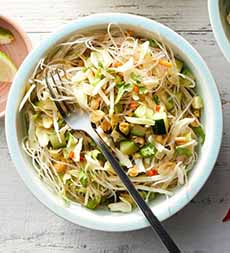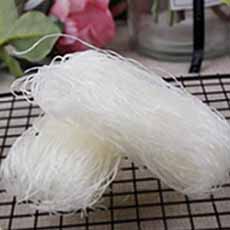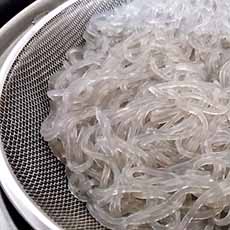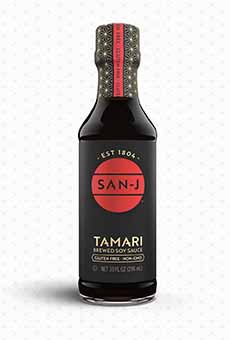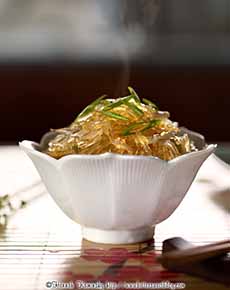Thai Glass Noodle Salad Recipe For National Salad Month
|
|
May is National Salad Month. Take a step sideways from conventional green salads and pasta salads, and try this different approach: Thai Glass Noodle Salad. (O.K., glass noodles aren’t technically pasta—they’re not made from wheat.) The recipe is from Taste Of Home, where it’s one their Best-Loved Grand Prize Winning Recipes. While there are many glass noodle salad recipes, this one was created by Laura Wilhelm of West Hollywood, California. It’s a first course or side salad, but you can add poached or grilled shrimp or shredded chicken to create a main course; even leftover steak. We used leftover lamb kabobs and they fit right in. > What are glass noodles? Read all about them below. > The history of soy sauce and tamari is also below. > Plus, the difference between soy sauce and tamari. > Related recipe: Vietnamese Cabbage Slaw. > The different types of pasta: a photo glossary. Just about anyone will enjoy the fresh, bright flavors in this crunchy Thai-style salad, served at room temperature or chilled. Prep time is 30 minutes plus chill time if desired. 1. COOK the noodles according to package directions; drain. Combine the noodles, coleslaw mix, cucumber, bean spouts, nuts, mint, cilantro, scallions and chile pepper. 2. LET sit to allow flavors to blend. You can place in the fridge to chill at the same time. When ready to serve… 3. ADD the dressing and toss to combine. Start by using a smaller amount of dressing; then add more as desired. Ingredients 1. WHISK together the tahini, oil, vinegar, tamari, ginger, and honey with 1 tablespoon water, until smooth. 2. ADD additional water to desired consistency. Refrigerate until ready to use. The ancestor of soy is a sauce called jan or jiang, made in ancient China. It was used for pickling raw materials in salt to preserve them. Jiang was a thick paste that was originally a blend of meat and a millet-based fermenting agent along with salt. This was placed in a jar, sealed, and allowed to ferment for at least 100 days. The meat dissolved, leaving behind a strong umami taste and a liquid condiment, jiang [source]. About 2,000 years ago, Chinese jiang makers began to substitute soybeans for meat. This version of jiang is considered to be the ancestor soy sauce. It is not clear when that ancestor came to Japan, where it was called “hishio.” According to the Taiho Code*, hishio made from soybeans was to be made at the Hishio Institute, part of the cuisine division of the Imperial Household Agency. That hishio was a variant between soy sauce and miso paste, and was served on the dining tables at palace banquets. Eventually separate condiments were created, miso remaining a paste and soy sauce, or shoyu, a liquid. The next step: The making of miso paste was begun using the Kinzanji method that the Zen monk Kakushin brought back from China in 1254 (source). The story goes that as the Zen monk Kakushin was teaching the technique of miso-making method to the villagers of Kishu Yuasa, he noticed that the liquid that seeped out of hishio was very tasty. It became what is now known as “tamari soy sauce” [source]. Are glass noodles “pasta?” No. “Pasta” is defined as made from semolina. While American and Italian pastas are made from durum wheat (semolina is the ground wheat kernel of durum), pasta can be made from other flours. Some northern European countries use other wheats or potatoes. Polish pierogi, Italian gnocchi and German spaetzle, which are generally referred to as dumplings, are also considered forms of pasta. They all are descended from the original wheat pasta made in China. Asian noodles, also called threads, can be made of rice, soybean, wheat, or other flours. The “glass noodles” used in Thai dishes are made from mung bean starch, potato starch, sweet potato starch, tapioca, and others. The opaque white Chinese noodles are made from rice flour or wheat flour, and Japanese soba noodles are made from buckwheat flour. Also known as bean threads, bean thread noodles, cellophane noodles, Chinese vermicelli, crystal noodles, or mung bean noodles, glass noodles become transparent when cooked. Harasume is the Japanese word. Originating in China more than a thousand years ago they are made from starch: batata starch, canna, cassava, mung bean starch (especially in China), potato starch, sweet potato or yam starch, tapioca, and others. Water and a stabilizer are also added. All these noodles are made without wheat, and thus gluten-free. Glass noodles absorb the flavors of other ingredients in the dish. They’re very versatile. Glass noodles spread to other parts of Asia…and out into the world. |
|
|
________________ †The Taihō Code, established 703 C.E., was the administrative and penal code of Japan (source). CHECK OUT WHAT’S HAPPENING ON OUR HOME PAGE, THENIBBLE.COM. |
||
